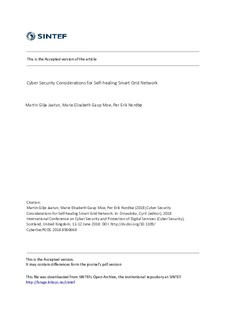| dc.contributor.author | Jaatun, Martin Gilje | |
| dc.contributor.author | Moe, Marie Elisabeth Gaup | |
| dc.contributor.author | Per Erik, Nordbø | |
| dc.date.accessioned | 2018-12-20T11:02:30Z | |
| dc.date.available | 2018-12-20T11:02:30Z | |
| dc.date.created | 2018-12-20T11:05:30Z | |
| dc.date.issued | 2018 | |
| dc.identifier.citation | 2018 International Conference on Cyber Security and Protection of Digital Services (Cyber Security), Scotland, United Kingdom, 11-12 June 2018, 200-206 | nb_NO |
| dc.identifier.isbn | 978-0-9932338-3-8 | |
| dc.identifier.uri | http://hdl.handle.net/11250/2578478 | |
| dc.description.abstract | Fault Location, Isolation and System Restoration (FLISR) mechanisms allow for rapid restoration of power to customers that are not directly implicated by distribution network failures. However, depending on where the logic for the FLISR system is located, deployment may have security implications for the distribution network. This paper discusses alternative FLISR placements in terms of cyber security considerations, concluding that there is a case for both local and centralized FLISR solutions. | nb_NO |
| dc.description.abstract | Cyber Security Considerations for Self-healing Smart Grid Networks | nb_NO |
| dc.language.iso | eng | nb_NO |
| dc.relation.ispartof | Cyber Science 2018 | |
| dc.relation.uri | https://ieeexplore.ieee.org/abstract/document/8560668 | |
| dc.title | Cyber Security Considerations for Self-healing Smart Grid Networks | nb_NO |
| dc.type | Chapter | nb_NO |
| dc.description.version | acceptedVersion | nb_NO |
| dc.source.pagenumber | 200-206 | nb_NO |
| dc.identifier.cristin | 1646086 | |
| dc.relation.project | Norges forskningsråd: 245412 | nb_NO |
| cristin.unitcode | 7401,90,13,0 | |
| cristin.unitname | Software Engineering, Safety and Security | |
| cristin.ispublished | true | |
| cristin.fulltext | postprint | |
| cristin.qualitycode | 1 | |
